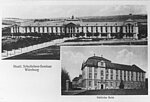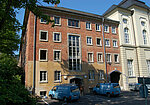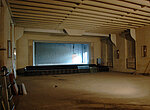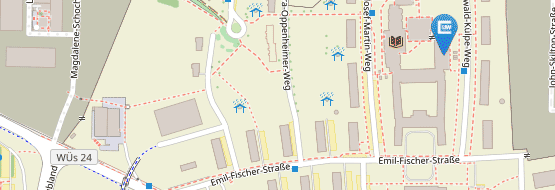Wittelsbacherplatz
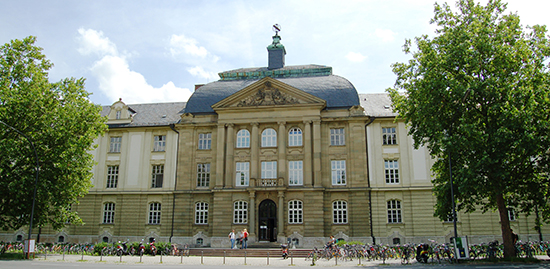
The University Building on Wittelsbacherplatz
A tradition of teacher training
Most students at the University building on Wittelsbacherplatz are studying to become teachers. And the palace-like building - almost 200 metres in length - that was inaugurated on 1 October 1898 has always been home to future teachers: Back in that day, it accommodated the Royal Teachers' College - and was located in an entirely unbuilt area.
A semi-circular forecourt served to reinforce the splendour of the building. This forecourt still exists today and so does Seinsheimstraße, the completely straight street leading up to the main portal.
Seinsheimstraße was named after Würzburg Prince-Bishop Adam Friedrich von Seinsheim (1708-1779), both an ecclesiastical and a secular monarch and a pioneer of teacher training. Opened by the Prince-Bishop in 1770, the Würzburg public teachers' college was the first of its kind in southern Germany. In the college's regulations, Seinsheim wrote: "A country's welfare is almost solely determined by the quality of its teaching institutions." The Prince-Bishop had obviously recognised the importance of education and training.
From 1770 onwards, the first nine carefully selected students received their teacher training at the University's own mint building. This was the first time that future teachers received training that was not - as had been usual up to that time - oriented towards the crafts. In addition, teacher training became a responsibility of the state.
Space problems followed by space problems
One of the major problems at that time was space. Since the mint building became ever more crowded, teacher training was moved to the rooms of the Carthusian Monastery in 1819 and, two years later, to the Augustinian Monastery situated on the site where police station Würzburg-Ost stands today.
But the problem of crowded rooms remained with the institution during the following years - a fact that was due to several reasons. Firstly, in 1824, the state made it compulsory that future teachers be educated at boarding schools. This led to an increased need for space to accommodate students. Secondly, the 19th century saw the transition from an agricultural to an industrial society, a transition that required enhancements to the education system. Numerous schools were founded and it was made compulsory that children attend school for seven years - up to that time, it had only been six years. Accordingly, the demand for teachers increased significantly. In 1800, 12 to 15 teachers were trained in Würzburg. This number rose to 82 in 1825 and 136 in 1885.
Chickens in the yard
Space problems at the Augustinian Monastery became even more severe when Latin schools (precursors of today's Gymnasium) moved into the building, too. But space was not the only problem. The chickens being kept in the yard were a source of annoyance to the residents and so was the dampness of the rooms - this dampness was the reason why many of the students and staff kept becoming ill.
Demands that new facilities be built for the college were finally fulfilled in 1898. The new building on Wittelsbacherplatz provided enough space for the students and staff of the teachers' college. It comprised four dormitories, a canteen kitchen with a dining hall as well as arts, handicrafts and music rooms and even a private chapel. The building also featured a Karzer, a detention cell for students who had committed serious violations of academic regulations.
Fire extinguished by wounded soldiers
Between 1935 and 1937, new lecture halls were added to the building on Wittelsbacherplatz and a year later, two gymnasiums and outbuildings were erected. Towards the end of World War II, wounded soldiers were accommodated in the north wing. In the night of the bombing raid on 16 March 1945, these soldiers extinguished fires on the ground floor and the rooftop. Thanks to them, the building suffered only minor damage during the war. After the war, the US Army occupied the building for three years. Then the military was replaced by culture. In 1948, the Würzburg Stadttheater moved into the gymnasium which had been subjected to some measures of conversion. The theatre remained there until 3 December 1966, the day before the opening of the new theatre in the building that still accommodates it today.
Undecided fate until 1977
In the following years, the fate of the building on Wittelsbacherplatz remained undecided. The question was whether to refurbish the building or to build new facilities for teacher training on the Hubland Campus. The University pondered this question for quite a long time - at the expense of the old building where many necessary refurbishment measures were left untaken.
Once the option of a new build had been discarded, however, the University got down to action in 1977. It had, among other measures, the electric and heating systems refurbished, a computer room set up, the roof retiled, the front of the building replastered and most of the interior renovated. The University spent a total of at least €7 million on the building.
New build and refurbishment from 2008 onwards
When the theatre wing was torn down from July 2008 onwards, refurbishment of the entire facilities on Wittelsbacherplatz entered into a new phase. The torn-down wing was replaced by a new build accommodating a central faculty library and two new lecture halls with 288 seats each. Operations in the new build were taken up in the spring term of 2011.
During the second phase of construction work, which started in 2011, the existing lecture halls were also torn down and replaced by a new build. This will accommodate the repository of the faculty library as well as office facilities for the Faculty of Human Sciences. Construction costs totalled to approximately €10.5 million.
Robert Emmerich
Source: „Lehrerbildung in Würzburg. 100 Jahre Lehre und Forschung am Wittelsbacherplatz“ ("Teacher training in Würzburg. 100 years of teaching and research on Wittelsbacherplatz"), Erich Hußlein, Lothar Katzenberger, Wolfgang Schneider (Hrsg.), Würzburg 1998, ISBN 3-923959






